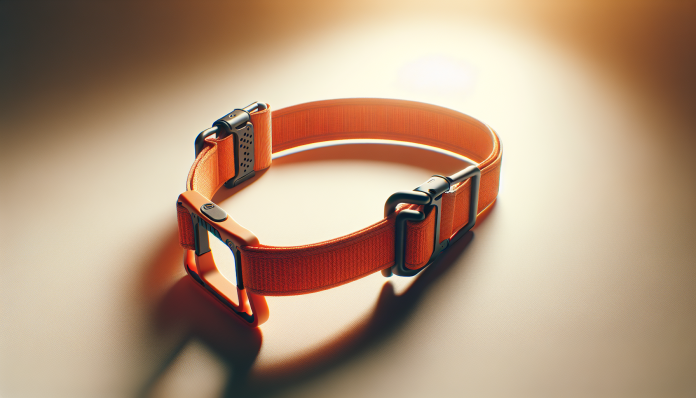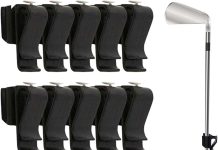Have you ever wondered whether a simple, portable device like the Callaway Swing Easy Golf Swing Trainer Aid, Orange can actually help me improve my golf swing?
My first impressions
I opened the package and immediately liked how simple the device looked and how bright the orange color made it easy to find in my bag. I felt optimistic because it didn’t seem complicated to use, and I could tell right away that it was designed to keep my arms and body working together rather than forcing an unnatural position.
What is the Callaway Swing Easy Golf Swing Trainer Aid, Orange?
The Callaway Swing-Easy is a full-swing training aid designed to help golfers of all levels groove a more consistent takeaway and keep the arms and torso working in sync. I see it as a lightweight, portable tool I can stash in my bag and use anywhere I practice — at the range, in the backyard, or even during short sessions on the course.
Design and materials
The device is built to feel durable yet flexible so it won’t break down quickly during repeated practice sessions. I liked that the materials feel sturdy enough to last through many swings but comfortable enough that it doesn’t irritate my skin or restrict natural motion.
Size and fit
Callaway made the Swing-Easy to fit a wide range of body types, and I found that it accommodates both right- and left-handed golfers without any special adjustments. I appreciated that I didn’t need to buy a separate model for different hand orientations or worry about it being too big or too small.
How it works
The Swing-Easy works by physically linking your hands and arms to your torso during the takeaway and swing, encouraging a one-piece motion that most instructors recommend. I felt that the gentle constraint keeps me honest about the early part of my swing and helps me avoid the arms-only takeaway that can lead to inconsistencies.
The one-piece takeaway principle
The goal of a one-piece takeaway is to have the arms, shoulders, and torso move together instead of having the hands fly independently early in the swing. When I use the Swing-Easy, it encourages that coordinated movement so that the club sits in a better position at the top of the backswing.
Arm and body sync
If your arms and body move in sync, you tend to square the clubface more consistently and maintain better swing plane. I noticed that by keeping the trainer in place, I had fewer instances of my arms getting too far ahead or behind my body during the takeaway.
Setup and use
I was able to set it up quickly without any special tools or a long instruction manual. The simplicity means I can get right to practicing rather than spending time fiddling with adjustments.
Getting it on your arms
Putting the Swing-Easy on involves positioning the connectors or straps (depending on the exact model) so that it links my arms to my body. I found it straightforward: a quick fit and then a few practice swings to make sure nothing was pinching or slipping.
Practicing swings on the range
On the range, I used it for warm-ups and specific practice segments focused on takeaway and tempo. I alternated between swings with the trainer and swings without it so I could feel the difference and try to carry the correct motion into my natural swing.
Training drills I recommend
I developed several drills around the Swing-Easy that I found especially effective for building muscle memory and addressing common swing flaws. Keeping drills simple made it easier for me to focus on one aspect of the swing at a time.
Basic full-swing drill
I stood with my normal setup and made full swings while wearing the trainer, focusing on maintaining the connection between my arms and torso on the takeaway. After a set of 10–15 swings, I removed the device and made the same number of swings to feel the difference — that contrast was key to reinforcing the correct motion.
Tempo and rhythm drill
I used a metronome app or counted out loud to establish a 3:1 tempo (three counts back, one count through) during practice swings with the Swing-Easy. I noticed my tempo and rhythm improved because I was forced to move my arms and body in sync rather than rushing the takeaway.
Short swing and control drill
I took half and three-quarter swings to focus on keeping the club on plane and avoiding over-rotation or casting. These shorter swings helped me control the path and maintain balance, and I felt the trainer made it easier to repeat those compact, controlled motions.
One-arm drills
I tried alternating one-arm swings while wearing the trainer to develop control and awareness of how each arm interacts with the torso. I felt this helped my weaker side and improved my overall coordination because the trainer still provided a reference for how the arms should connect to the body.
Putting it in play: pre-shot routine drill
I used the Swing-Easy as part of my warm-up before rounds to ingrain the takeaway during my pre-shot routine. I performed a few swings with it, then took a few normal swings, and finally went to a short target shot — this helped carry the feeling into actual shot-making.
Benefits I noticed
Using the Swing-Easy delivered several practical benefits that made it worth incorporating into my practice. The improvements were not always dramatic overnight, but consistent use gave me measurable gains.
- Improved takeaway consistency: I had fewer early hand flips and more repeatable top-of-swing positions.
- Better synchronization: My arms and torso moved together more often, which reduced compensations.
- Portability and convenience: I could keep it in my bag and use it wherever I practiced.
- Suited for beginners: I saw quick returns for new players who need to learn basic mechanics.
- Works for all golfers: Because it fits both right- and left-handers and various body sizes, it’s flexible for many users.
Limitations and who might not like it
While I appreciate the simplicity, I also recognize it’s not a universal fix and doesn’t address every swing issue. I found that some advanced players who already have a very well-grooved swing might find it unnecessary or even feel it interferes with their natural motion.
- Not a complete solution: It focuses on takeaway and syncing arms with the body, but it doesn’t teach everything (e.g., grip, impact dynamics, advanced sequencing).
- Can create dependence: If I used it exclusively, I risked becoming reliant on the device’s tactile feedback rather than transitioning the feeling to my unassisted swing.
- Limited for short-game: It’s primarily a full-swing aid and has little to offer for putting or delicate chip shots.
Specification table
I put together a concise table to break down the key facts and features in a single glance so I and others can quickly compare basics.
| Feature | Detail |
|---|---|
| Product name | Callaway Swing Easy Golf Swing Trainer Aid, Orange |
| Purpose | Full-swing training aid to promote a one-piece takeaway and arm-body sync |
| Color | Orange |
| Handedness | Suitable for right- and left-handed golfers |
| Fit | Designed to fit golfers of most sizes |
| Portability | Lightweight and compact; stores in a golf bag |
| Ideal for | Beginners and intermediate golfers; handy for warm-ups |
| Included items | Trainer unit (exact package contents may vary by retailer) |
| Material feel | Durable, flexible construction (lightweight) |
| Primary benefits | Takeaway consistency, improved tempo, arm-body connection |
How it compares to other swing trainers
I compared it mentally to a few other popular devices I’ve tried or read about, and the Swing-Easy stands out for its simplicity and portability. Some trainers focus on resistance, others on weight or tempo; this one mainly enforces a coordinated movement pattern.
Comparison summary
Compared to weighted trainers like the Orange Whip or hinged trainers like Tour Striker, the Swing-Easy is less about building strength and more about enforcing movement patterns. I felt it was gentler and more instructional for beginners, while devices with weight build muscle memory for tempo and conditioning.
My practice routine with it
I established a routine that fit into my normal practice sessions and found that consistency, more than duration, mattered most. I used it a few times per practice session rather than throughout every swing to avoid over-reliance.
- Warm-up: 5–10 swings with the Swing-Easy to groove the takeaway.
- Focus segment: 15–25 swings concentrating on one drill (tempo, half-swings, etc.).
- Reinforcement: 10 swings without the aid to test carryover into my natural motion.
- On-course warm-up: 3–5 swings before teeing off to remind my body of the feel.
I noticed that alternating between trainer-supported swings and regular swings helped me translate the correct motion back into play.
Results I saw: short-term and long-term
Short-term, I gained a clearer awareness of my takeaway and felt more confident in the early part of my swing. Long-term, consistency improved and I noticed a measurable reduction in mishits caused by early hand action.
- Short-term: Immediate feedback on incorrect arm-only movements and faster recognition of what a one-piece takeaway feels like.
- Long-term: Better repeatability in the swing path, more consistent contact, and fewer compensations during the downswing.
Tips and common mistakes
I learned a few dos and don’ts that helped me get better results fast and avoid common pitfalls with training aids like this.
- Do focus on feel, not position: I use it to feel the connection rather than trying to force a rigid pose.
- Do alternate: I always alternate swings with and without the trainer to avoid dependence.
- Don’t overuse: Long sessions every day can make me reliant on the tactile cue.
- Don’t expect instant perfection: Muscle memory takes time; persistence matters more than intensity.
- Do record yourself: A short video during practice helped me verify that the takeaway changed in the intended way.
Maintenance and care
It’s a low-maintenance device, but I still take a few simple steps to keep it in good condition. I wipe it down after sweaty sessions and store it in my bag where it won’t be crushed or misshapen.
- Clean regularly: A damp cloth and mild soap are enough if it gets dirty.
- Avoid extreme heat: Don’t leave it baking in a hot trunk for long periods.
- Check connectors: Make sure any straps or joints remain secure and intact.
Price and value
I considered price relative to the improvements I experienced and found it to be a good value for the money. Because it’s inexpensive compared to coaching sessions and large training systems, I see it as a solid supplement to lessons or independent practice.
- Affordable: The cost is reasonable for a basic, effective training aid.
- High value for beginners: Players just starting can pick up foundational mechanics without expensive lessons.
- Complementary: I still recommend combining it with periodic coaching or video analysis for best results.
Pros and cons (concise)
I like to keep a short pros-and-cons list to help remind myself and others what to expect before purchasing and using the product.
Pros:
- Simple and effective for takeaway and arm-body connection.
- Portable and easy to use on the range or during warm-ups.
- Suitable for both right- and left-handed golfers.
- Good value for beginners and intermediate players.
Cons:
- Not a full swing system; doesn’t address impact specifics or grip.
- Potential for dependence if overused.
- Limited usefulness for short game and putting.
Troubleshooting common issues
When I first used the Swing-Easy, a few small issues popped up; here’s how I handled them and what I recommend.
- Slipping or shifting during swings: I checked the fit and made sure straps or connectors were snug but not tight.
- Feeling restricted or uncomfortable: I took a few swings to adjust the position and avoided forcing my body into a rigid posture.
- No carryover into normal swings: I increased the number of alternating swings without the device to help the feel transfer into my unassisted swing.
Who should buy it
I think this trainer is ideal for certain types of golfers and situations, and less necessary for others. I’d recommend it most strongly to the following:
- Beginners who need to learn a coordinated takeaway and basic sequencing.
- Intermediate players looking to clean up early hand action.
- Golfers who travel and want a compact aid to keep in their bag.
- Coaches who want a simple tool to demonstrate the one-piece takeaway concept.
I wouldn’t recommend it as a primary tool for players who already have a highly refined swing or for golfers seeking to specifically work on weight shift, impact dynamics, or short-game touch.
Alternatives and when to choose them
If your main issue is tempo or strength, you might prefer a weighted trainer like Orange Whip; if you need to feel clubhead lag and consistency through impact, a hinged trainer or impact bag could be more appropriate. I selected the Swing-Easy specifically to train connection and takeaway, so I’d choose other tools when my goals differ.
Final verdict
I found the Callaway Swing Easy Golf Swing Trainer Aid, Orange to be a practical, affordable device that genuinely helped me improve takeaway consistency and arm-body sync. I appreciate its simplicity and portability, and when I used it as part of a balanced practice routine, I saw meaningful results.
I recommend it for beginners and intermediate players who want a no-frills way to ingrain a better takeaway and overall coordination. Just remember to use it thoughtfully — alternate swings with and without it, avoid overuse, and consider pairing it with occasional coaching or video feedback for the best long-term improvement.
Frequently asked questions
I answered a set of questions I commonly hear from friends and fellow golfers to help clarify practical points about the trainer.
Q: Is it easy to use for left-handed players? A: Yes. The design accommodates both right- and left-handed golfers without needing separate models.
Q: Will it fix my slice? A: It can help if your slice is caused by an arms-only takeaway or poor arm-body synchronization, but it won’t fix all causes of slicing. Other factors like clubface control and path still need work.
Q: How often should I use it? A: I used it a few times per practice session rather than every swing. Short, focused sessions a few times a week worked best for me.
Q: Can it be used for irons and woods? A: Yes. I used it with both irons and woods to build the same takeaway feeling across clubs.
Q: Will I become dependent on it? A: There’s a risk if you overuse it. I always alternate swings without the device to ensure I’m not dependent on the tactile cue.
Q: Is it durable? A: In my experience, it feels durable for regular practice. Proper storage and avoiding extreme heat will extend its lifespan.
Q: Do I need lessons to use it? A: Lessons aren’t required, but combining the trainer with periodic coaching or video analysis speeds progress and helps avoid reinforcing incorrect habits.
Q: Is it suitable for juniors? A: It can be, provided it fits properly and the junior golfer uses it with supervision to ensure correct usage and avoid discomfort.
If you want, I can create a short practice plan tailored to your current skill level and the specific issues you want to address with the Callaway Swing Easy Golf Swing Trainer Aid, Orange — just tell me what part of your swing you struggle with most, and I’ll put one together.
Disclosure: As an Amazon Associate, I earn from qualifying purchases.







































